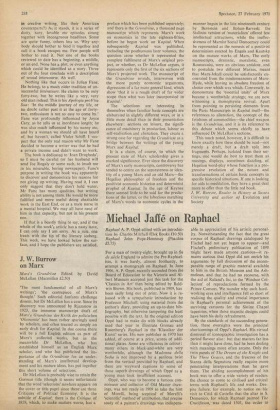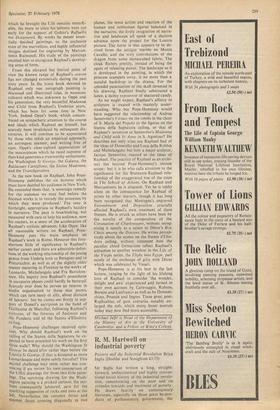Michael Jaff6 on Raphael
For a man of twenty-eight, brought up in fin de siècle England to admire the Pre-Raphael- ites, it was hardy, almost foolhardy, to attempt a monograph on Raphael. In June 1906, A. P. Opp& recently seconded from the Board of Education to the Victoria and Al- bert Museum accepted just this task for the 'Classics in Art' then being edited by Bald- win Brown. His book, published in 1909, has been sadly long out of print. Now it is re- issued with a sympathetic introduction by Professor Mitchell, using material from the author's diary, providing an up-to-date bib- liography, but otherwise tampering the least possible with the text. In the original edition Give had to make do with blocks already used that year to illustrate Gronau and Rosenberg's Raphael in the `Klassiker der Kunst' series. His new publisher in 1970 has added, of course at a price, scores of addi- tional plates. Some are villainous in colour: many others in black-and-white are very worthwhile, although the Madonna della Sedia is not improved by a perilous twist from the vertical provided by Raphael, and there are wayward captions to some of those superb drawings of which Oppe as a young man took insufficient account.
Opp& who was to become a famous con- noisseur and collector of Old Master draw- ings, was not ready in 1909 to take the hint of Morelli, being sceptical of Morelli's 'scientific' method of attribution, that precise study of a painter's drawings was indispens, able to appreciation of his artistic personal- ity. Notwithstanding the fact that the great corpus of Raphael drawings catalogued by Fischel had not yet begun to appear—and Fischel's preliminary publication of 1898 might have made anyone .cautious—it re- mains curious that Oppt did not enrich his arguments by full discussion of the incom- parable range of graphic material available to him in the British Museum and the Ash- molean, and that he had no recourse, with the aid of Ruland's list, to the 'Windsor Col- lection' of reproductions formed by the Prince Consort. We wonder why such hard- working eyes and intelligence fell so short of realising the quality and crucial importance in Raphael's personal achievement of the surviving cartoons for the Sistine Chapel tapestries, when those majestic designs could have been his daily refreshment.
By the standards of the succeeding genera- tion, these oversights were the principal shortcomings of Oppe's Raphael. His virtual dismissal of iconographic investigation has a period flavour also: but that matters far less than it might have done, had he been dealing with meanings more often arcane. Only the twin panels of The Dream of the Knight and The Three Graces, and the frescoes of the Stanza della Segnatura really require more penetrating interpretations than he gave them. The abiding accomplishment of his book was to offer a wide variety of readers the chance to come to civilised and critical terms with Raphael's life and works. Des- pite failure. for example, to notice on his visit to Cittil di Castello that the altar in S. Domenico, for which Raphael painted The Crucifixion, was dated 1503, the order to which he brought the Life remains remark- able, the more so since his labours were too early for the support of Golzio's Ragaello nei Docutnenti. By works he meant essen- tially finished paintings, to the exclusion even of the marvellous, and highly influential designs destined for engraving by Marcan- tonio Raimondi. His study of the paintings enabled him to excogitate Raphael's develop- ing sense of form.
From this elevated but limited point of view the known range of Raphael's oeuvre has not changed extensively during the past sixty years. In the latest book devoted to Raphael only one autograph painting is discussed and illustrated (alas, in nauseous colours) which was unknown to Oppe. and his generation; the very beautiful Madonna and Child from Raphael's Umbrian years, which has been for some time in New 'York. Indeed Oppe's book, which concen- trated on sympathetic attention to the course and ideals which Raphael set himself, has scarcely been invalidated by subsequent dis- coveries. It will continue to .be appreciated by those who relish an empirical approach, an astringent manner, and writing free of cant. Oppe's clear-sighted appreciation of the masterpieces which he rated supreme of their kind generates a trustworthy enthusiasm: the Washington St George, the Galatea, the Baldassare Castiglione, the Sistine Madonna, and the Transfiguration In the new book on Raphael, John Pope- Hennessy publishes the six lectures which must have dazzled his audience in New York. He reminded them that, 'a sovereign remedy for the staleness we may feel before the finished works is to restudy the processes by which they were produced.' The tone is forthright, appropriate to Raphael's lucidity in narrative. The pace is breathtaking, but measured with care to help his audience, now his readers, to a sense of the acceleration of Raphael's stylistic advances. Like Opp& like all reasonable writers on Raphael, Pope- Hennessy puts the main emphasis on Raphael's work in Rome. However this fore- shortens little of significance in Raphael's
earlier career; and there are admirable-definitions of the working relationship of the young
genius from Umbria both to Perugino and to Pinturicchio, as well as of the slightly older master maturing in Florence to the works of Leonardo, Michelangelo and Fra Bartolom- meo. His inquiry into Raphael's procedures in successive phases could hardly be bettered. Scarcely ever does he pursue an interest in studio organisation to those nice points, Which can turn nasty or silly, about division of labours: but 'he comes out firmly in sup- port of Donati's ascription to the hand of Guillaume de Marcillat, following Raphael's cartoons, of the frescoes of Justinian and the Pandects and of the Stanza d'Eliodoro ceiling..
Pope-Hennessy challenges received opin- ions. Why should Raphael's work on the ceiling of the Stanza della Segnatura be ex- pected to have preceded his work on the first three walls? Why should the Washington St George be dated after rather than before the Louvre St George, if that is accepted as more Leonardesque and more subtly forceful? This second challenge may seem rather less con- vincing if we review his own comparison of the Uffizi drawings for those two little paint- tngs. The surviving drawing for the Wash- ington painting is a pricked cartoon, the out- lines consequently laboured, save for the sparkling suggestion of rocks and trees at the left. Nevertheless the complex thrust and counter thrust crossing diagonally in two planes, the tense action and reaction of the human and subhuman figures balanced in the narrative, the lively integration of narra- tive and landscape all speak of a decisive advance upon the project for the Louvre picture. The horse in that appears to be de- rived from the antique marble on Monte Cavallo, and the wiry convolutions of the dragon from some damascened fabric. The cloak flutters prettily, instead of being the agent of releasing power. The landscape as it is developed in the painting, in which the princess scampers away, is no more than a tasteful backdrop to the drama. For the splendid punctuation of the skull invented in his drawing, Raphael finally substituted a lance, a dainty repoussoir of shattered candy.
As we might expect, Raphael's affinity to sculpture is treated with masterly under- standing. Who but Pope-Hennessy would have suggested the relationship of Andrea Sansovino's Virtues on the tombs in the choir of S. Maria del Popolo to the figures on the Stanza della Segnatura ceiling, or that of Raphael's invention to Sansovino's Madonna and Child with St Anne in S. Agostino? He describes not only what use Raphael had of the ideas of Donatello and Luca della Robbia and Michelangelo, but how a major sculptor, Jacopo Sansovino, reacted to the ideas of Raphael. The practice of Raphael as an archi- tect lies beyond Pope-Hennessy's chosen scope: but it is he who calls attention to the significance for the Bramante-Raphael rela- tionship of the exaggerated rise of the steps in The School of Athens. On Raphael and Marcantonio he is eloquent. Yet he is oddly silent on the consequence for Raphael of prints by other masters, though it has long been recognised that Mantegna's engraved Entombment and Deposition crucially affected Raphael's own treatment of these themes. He is struck as others have been by the novelty of the composition of the Coronation of Charlemagne, without recog- nising it openly as a salute to Diirer's Boy Christ among the Doctors. He writes percep- tively about the scenes on the Stanza d'Elio- doro ceiling, without comment how the peculiar cloud formations reflect Raphael's attraction to another woodcut in the Life of the Virgin series, the Flight into Egypt, part surely of the exchange of gifts with Dilrer which was celebrated by Vasari.
Pope-Hennessy is at his best in the last lecture, ranging by the light of his lifelong love of Raphael to consider 'the wonder, delight and awe' experienced and turned to their own account by Caravaggio, Rubens, Bernini and Lanfranco as well as by Domeni- chino, Poussin and Ingres. These great post- Raphaelites of past centuries notably en- larged the cult, which many lesser mortals today may now find more accessible.
Michael lath." is Head of the Department of the History of Art at the University of Cambridge, and a Fellow of King's College.



































 Previous page
Previous page